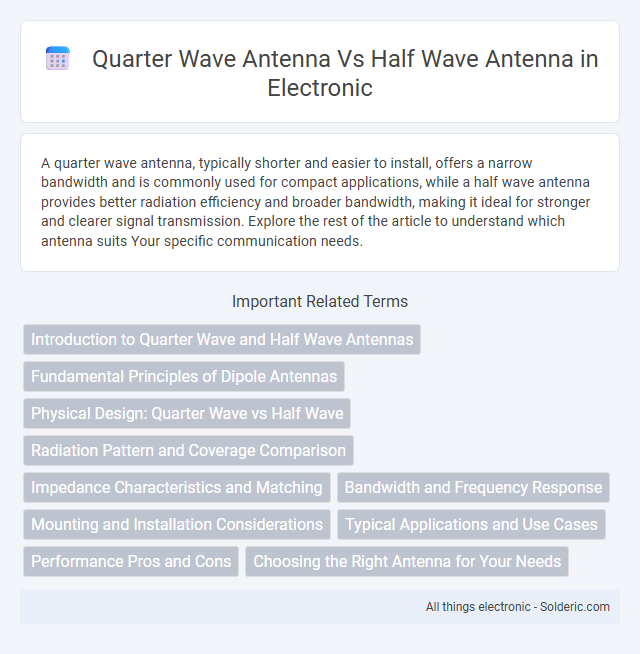A quarter wave antenna, typically shorter and easier to install, offers a narrow bandwidth and is commonly used for compact applications, while a half wave antenna provides better radiation efficiency and broader bandwidth, making it ideal for stronger and clearer signal transmission. Explore the rest of the article to understand which antenna suits Your specific communication needs.
Comparison Table
| Feature | Quarter Wave Antenna | Half Wave Antenna |
|---|---|---|
| Length | l/4 (quarter wavelength) | l/2 (half wavelength) |
| Impedance | ~36.5 O | ~72 O |
| Radiation Pattern | Omnidirectional in horizontal plane | Bidirectional in horizontal plane |
| Gain | Lower gain | Higher gain |
| Bandwidth | Narrower bandwidth | Wider bandwidth |
| Physical Size | Smaller, compact | Larger, longer |
| Feed Type | Requires ground plane (counterpoise) | No ground plane needed |
| Applications | Mobile, base stations, FM/AM radio | TV antennas, HF communication, base stations |
Introduction to Quarter Wave and Half Wave Antennas
Quarter wave antennas measure approximately one-quarter of the operational wavelength, providing efficient impedance matching and compact size ideal for portable and constrained applications. Half wave antennas span about half the wavelength, offering higher gain and superior radiation efficiency suitable for fixed, high-performance installations. Both antenna types are fundamental in radio communications, with quarter wave antennas favored for simplicity and half wave antennas preferred for enhanced signal strength.
Fundamental Principles of Dipole Antennas
Quarter wave antennas operate as monopoles with a single radiating element approximately one-quarter wavelength long, using the ground plane as a reflective surface to create the effect of a half wave dipole. Half wave antennas function as true dipoles with two quarter wave elements positioned end-to-end, allowing efficient radiation by balancing current distribution along both arms. The fundamental principle behind both antennas involves resonance at half the wavelength, enabling maximum radiation efficiency and impedance matching when the antenna length corresponds to a fraction of the signal wavelength.
Physical Design: Quarter Wave vs Half Wave
Quarter wave antennas measure approximately one-quarter of the wavelength, resulting in a shorter, more compact design ideal for limited space applications, whereas half wave antennas are about half the wavelength long, offering a larger physical size with improved radiation efficiency and gain. The quarter wave antenna typically requires a ground plane to function effectively, while the half wave antenna can operate as a standalone element without that necessity. Your choice between the two depends on physical space constraints and desired antenna performance characteristics.
Radiation Pattern and Coverage Comparison
A quarter wave antenna typically exhibits an omnidirectional radiation pattern in the horizontal plane, providing broad coverage with a higher elevation angle, making it ideal for ground-level communication. In contrast, a half wave antenna offers a more focused radiation pattern with greater gain and lower elevation angle, enabling longer-range and directional coverage. Your choice depends on whether you prioritize widespread, uniform coverage from a quarter wave or enhanced signal strength and distance with a half wave antenna.
Impedance Characteristics and Matching
Quarter-wave antennas typically exhibit an impedance around 36.5 ohms at the feed point, closely matching the characteristic impedance of common coaxial cables, which simplifies impedance matching. Half-wave antennas present a higher feed point impedance, usually around 70 to 75 ohms, requiring additional matching networks or baluns to optimize power transfer. Proper impedance matching in either antenna type minimizes signal reflection, maximizing radiation efficiency and overall system performance.
Bandwidth and Frequency Response
A quarter wave antenna typically offers narrower bandwidth and a more limited frequency response compared to a half wave antenna, which provides a wider bandwidth and improved frequency range. The half wave antenna's resonant structure allows it to efficiently transmit and receive signals over a broader spectrum, making it more versatile for varying frequency applications. Bandwidth performance of quarter wave antennas is often constrained by their shorter physical length and matching requirements, resulting in reduced frequency adaptability.
Mounting and Installation Considerations
Quarter wave antennas require a proper ground plane for optimal performance, often needing a metal surface or radial wires for mounting, which can limit installation flexibility. Half wave antennas are generally self-resonant and do not require an extensive ground plane, making them easier to install on various structures such as poles or masts. The simpler installation of half wave antennas often results in improved signal consistency and reduced interference compared to quarter wave antennas.
Typical Applications and Use Cases
Quarter wave antennas are commonly used in mobile communication devices and vehicle-mounted radios due to their compact size and ease of installation on metal surfaces acting as a ground plane. Half wave antennas find typical application in base stations, amateur radio, and broadcast transmissions where higher gain and better radiation patterns are required for extended range and signal quality. Both antennas are essential in wireless communication systems, with quarter wave antennas preferred for portability and half wave antennas favored for performance and efficiency.
Performance Pros and Cons
Quarter wave antennas offer compact size and easier installation, making them ideal for limited space applications, but they generally provide lower gain and narrower bandwidth compared to half wave antennas. Half wave antennas deliver superior performance with higher gain and broader bandwidth, enhancing signal strength and reception quality, yet they require more space and can be more challenging to mount. Your choice depends on balancing size constraints against the need for enhanced signal performance in your specific use case.
Choosing the Right Antenna for Your Needs
A quarter wave antenna offers a compact and efficient solution for limited space applications, typically requiring a ground plane to function optimally, making it ideal for portable and mobile devices. In contrast, a half wave antenna delivers higher gain and broader bandwidth, suited for fixed installations where performance and signal strength are crucial. Selecting the right antenna depends on factors like available space, frequency range, and desired signal quality to ensure optimal communication performance.
quarter wave antenna vs half wave antenna Infographic

 solderic.com
solderic.com